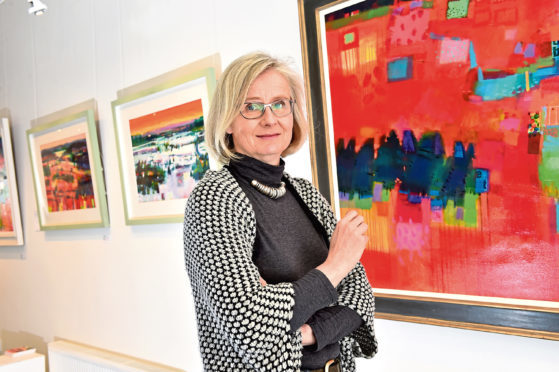Running her own art gallery has been a dream come true for Aberdeen businesswoman Maura Tighe.
She has owned Gallery Heinzel for 18 years and, in that time, has experienced at first hand the impact of the north-east oil industry’s highs and lows.
Maura describes running her own gallery as a “labour of love”.
The 50-year-old was born in Dublin and, after attending university there in the late 1980s, worked as a project manager in design, public relations and advertising agencies in south-east Ireland, London and Edinburgh.
But art has always been close to her heart.
While living in Edinburgh, she and her husband, Jon Brain, first starting buying original art.
The advertising agency where Maura worked was in the centre of the Scottish capital and she would visit galleries during her lunch hour.
She used to say to herself that if her lottery numbers ever came up she’d love to run a gallery.
Her business dream finally came true after moving to the north-east – although it wasn’t financed by a lottery jackpot.
Maura said: “In 1998, my husband, who works in the oil industry, got a job onshore in Aberdeen, just as we started a family.
“Through friends made at the antenatal group I was introduced to Gallery Heinzel, which was then in the city’s Spa Street.
“ I used to visit as a customer and, by chance, overheard Chris Heinzel, its founder, mention that she was looking for a part-time gallery assistant. We hit it off and I started work.
“That was in 1999. Chris was looking to sell the business as she’d moved to Germany to care for her parents. I bought the business as a going concern in 2000.
“Two years later I relocated it to Thistle Street, remortgaging the house to help finance the move. There were a few sleepless nights.”
Maura said the most recent downturn in the oil industry had hit her business.
“In 2014 in Aberdeen it was as if there was no tomorrow – there were plenty of buyers and money around.
“The housing market was very strong at that time and people were continually buying paintings for new homes.
“But when we got into 2015 the rush of customers stopped. It was like falling off a cliff.
“My business turnover went from being way over average in 2014 to being way below in 2015. I had to adjust to this new normality, and so I expanded the geographic markets I was serving.
“My new website helped me with this, and I also went to art fairs in London, However, the uncertainty following the Brexit vote has since hit the London market.”
Fortunately for Maura, business in Aberdeen started to pick up again last year.
“People here are starting to spend again as confidence returns,” she said.
Maura said the biggest change over the 16 years she has spent on Thistle Street has been the internet and social media.
“It is both a threat and a fantastic opportunity. Whereas before I used sell paintings predominantly to people living within a 30-mile radius of Aberdeen, I now also send paintings to London, Glasgow, Edinburgh, Europe, the US and Canada.
“Although the majority of my sales are still within that 30-mile radius, a whole new market has opened up.
“Art fairs and the internet have expanded the market and appetite for original art. Although an original artwork is still an indulgence, it is no longer the elitist luxury it once was.
“Thanks to schemes such as Own Art – interest-free credit underwritten by Creative Scotland – a person can own an original for less than they spend on a phone contract each month.”
Maura said an art gallery is not a quick road to riches and the sector has its share of casualties, explaining: “There are tight business margins. I could actually make more money by leasing out the gallery unit.”
Gallery Heinzel hosts seven exhibitions a year by artists from across Scotland. Assisting Maura is long-serving part-time employee Lois Carson.
There is space in the gallery for up to 150 paintings, with the most expensive one Maura has sold fetching around £10,000.
Maura acts as an agent for the artists, and gets paid when a painting finds a buyer.
She added: “Selling paintings is a tough trade. There is competition between galleries to attract the best new artists, and immense competition for customers.
“Whereas customers could previously only buy art from a gallery, then from art fairs, now they can buy from local galleries, art fairs, from galleries across the country/globe, pop-up events such as charity exhibitions and directly from artists via open-studio events and the internet.
“The market for original art is larger than it was 20 years ago, however maintaining a share of it is a constantly evolving business.
“The gallery sector, like most high-street retail, is under pressure. However I’m optimistic about its future.”
